Case Study Analysis: Gordon Deltori and the Clinical Reasoning Cycle
VerifiedAdded on 2022/08/29
|8
|2406
|21
Case Study
AI Summary
This case study analyzes the case of a 68-year-old taxi driver, Mr. Gordon Deltori, who presented to the emergency department with chest pain. The paper utilizes the clinical reasoning cycle to assess his condition, which includes a dull, achy chest pain radiating to his neck, and a history of hypertension, osteoarthritis, type-II diabetes, atrial fibrillation, and smoking. The analysis involves gathering information, processing it, identifying issues like angina and patient's lack of understanding about his health conditions, setting care goals, developing action plans, and evaluating outcomes. The assignment also discusses the pharmacokinetics of two of Mr. Deltori's prescribed medications, perindopril and anginine. The goal is to provide relief from the pain and educate the patient on the importance of regular check-ups and medication adherence. The conclusion highlights the importance of early education and interventions to prevent the progression of the patient's conditions.
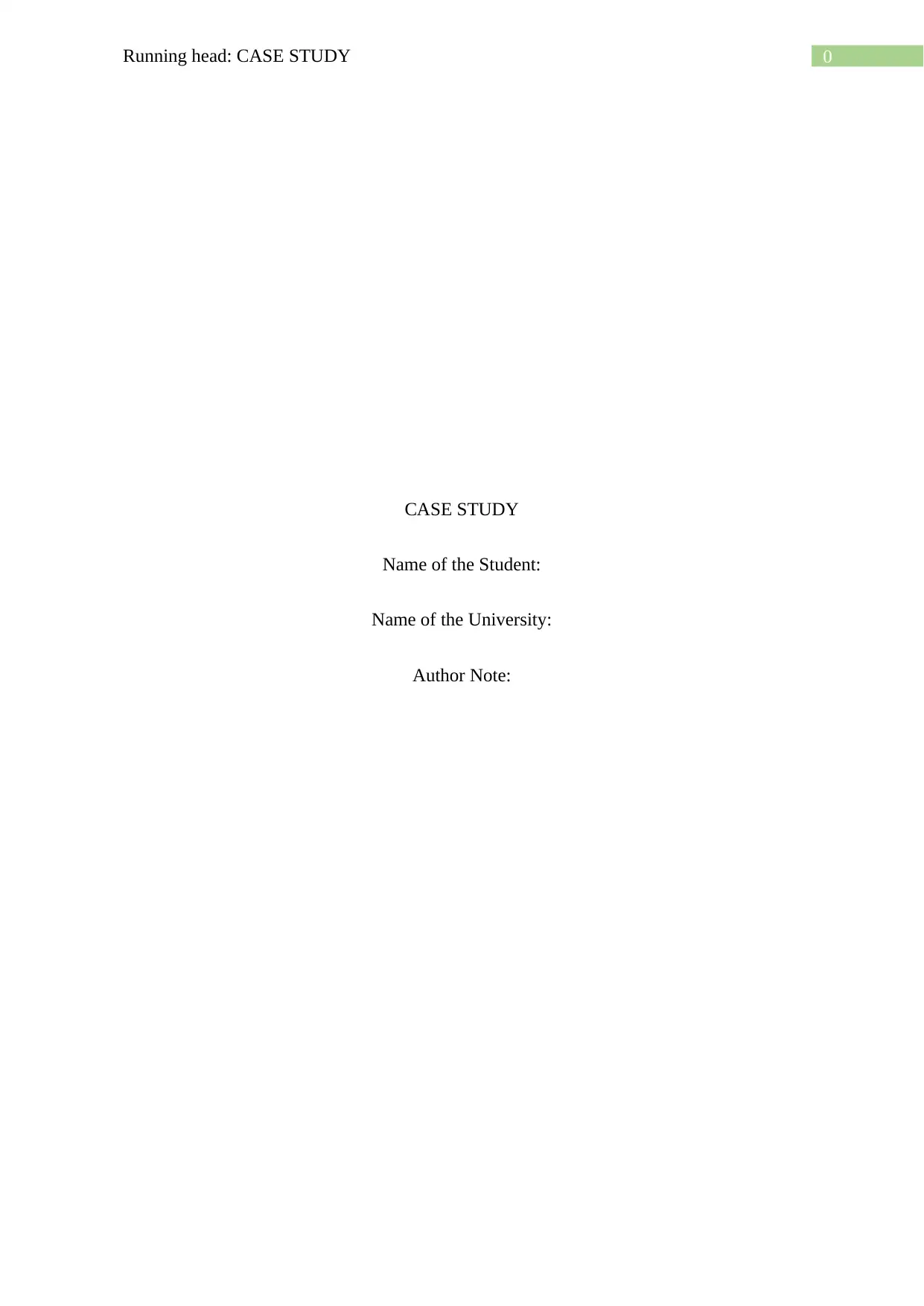
0Running head: CASE STUDY
CASE STUDY
Name of the Student:
Name of the University:
Author Note:
CASE STUDY
Name of the Student:
Name of the University:
Author Note:
Paraphrase This Document
Need a fresh take? Get an instant paraphrase of this document with our AI Paraphraser
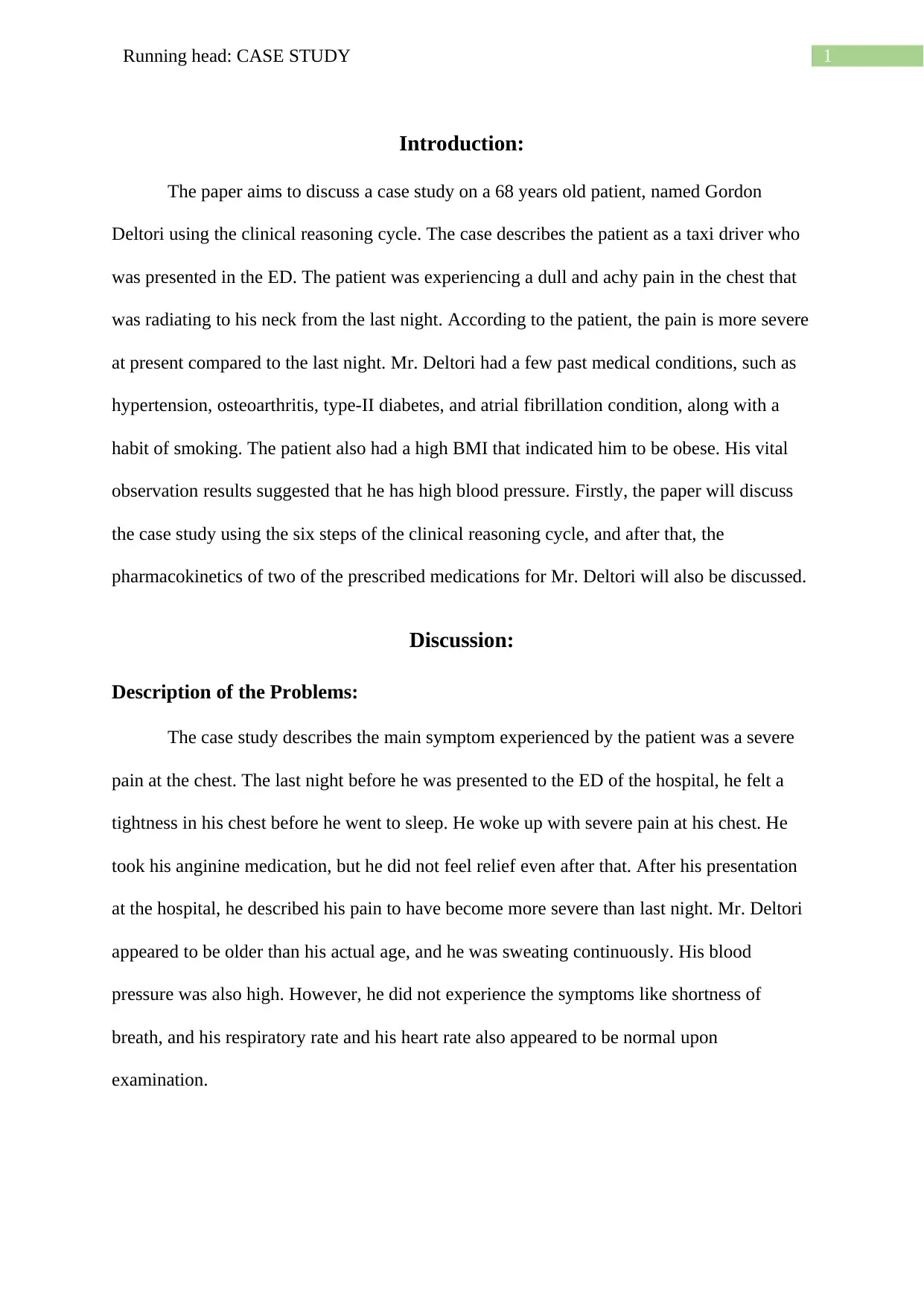
1Running head: CASE STUDY
Introduction:
The paper aims to discuss a case study on a 68 years old patient, named Gordon
Deltori using the clinical reasoning cycle. The case describes the patient as a taxi driver who
was presented in the ED. The patient was experiencing a dull and achy pain in the chest that
was radiating to his neck from the last night. According to the patient, the pain is more severe
at present compared to the last night. Mr. Deltori had a few past medical conditions, such as
hypertension, osteoarthritis, type-II diabetes, and atrial fibrillation condition, along with a
habit of smoking. The patient also had a high BMI that indicated him to be obese. His vital
observation results suggested that he has high blood pressure. Firstly, the paper will discuss
the case study using the six steps of the clinical reasoning cycle, and after that, the
pharmacokinetics of two of the prescribed medications for Mr. Deltori will also be discussed.
Discussion:
Description of the Problems:
The case study describes the main symptom experienced by the patient was a severe
pain at the chest. The last night before he was presented to the ED of the hospital, he felt a
tightness in his chest before he went to sleep. He woke up with severe pain at his chest. He
took his anginine medication, but he did not feel relief even after that. After his presentation
at the hospital, he described his pain to have become more severe than last night. Mr. Deltori
appeared to be older than his actual age, and he was sweating continuously. His blood
pressure was also high. However, he did not experience the symptoms like shortness of
breath, and his respiratory rate and his heart rate also appeared to be normal upon
examination.
Introduction:
The paper aims to discuss a case study on a 68 years old patient, named Gordon
Deltori using the clinical reasoning cycle. The case describes the patient as a taxi driver who
was presented in the ED. The patient was experiencing a dull and achy pain in the chest that
was radiating to his neck from the last night. According to the patient, the pain is more severe
at present compared to the last night. Mr. Deltori had a few past medical conditions, such as
hypertension, osteoarthritis, type-II diabetes, and atrial fibrillation condition, along with a
habit of smoking. The patient also had a high BMI that indicated him to be obese. His vital
observation results suggested that he has high blood pressure. Firstly, the paper will discuss
the case study using the six steps of the clinical reasoning cycle, and after that, the
pharmacokinetics of two of the prescribed medications for Mr. Deltori will also be discussed.
Discussion:
Description of the Problems:
The case study describes the main symptom experienced by the patient was a severe
pain at the chest. The last night before he was presented to the ED of the hospital, he felt a
tightness in his chest before he went to sleep. He woke up with severe pain at his chest. He
took his anginine medication, but he did not feel relief even after that. After his presentation
at the hospital, he described his pain to have become more severe than last night. Mr. Deltori
appeared to be older than his actual age, and he was sweating continuously. His blood
pressure was also high. However, he did not experience the symptoms like shortness of
breath, and his respiratory rate and his heart rate also appeared to be normal upon
examination.
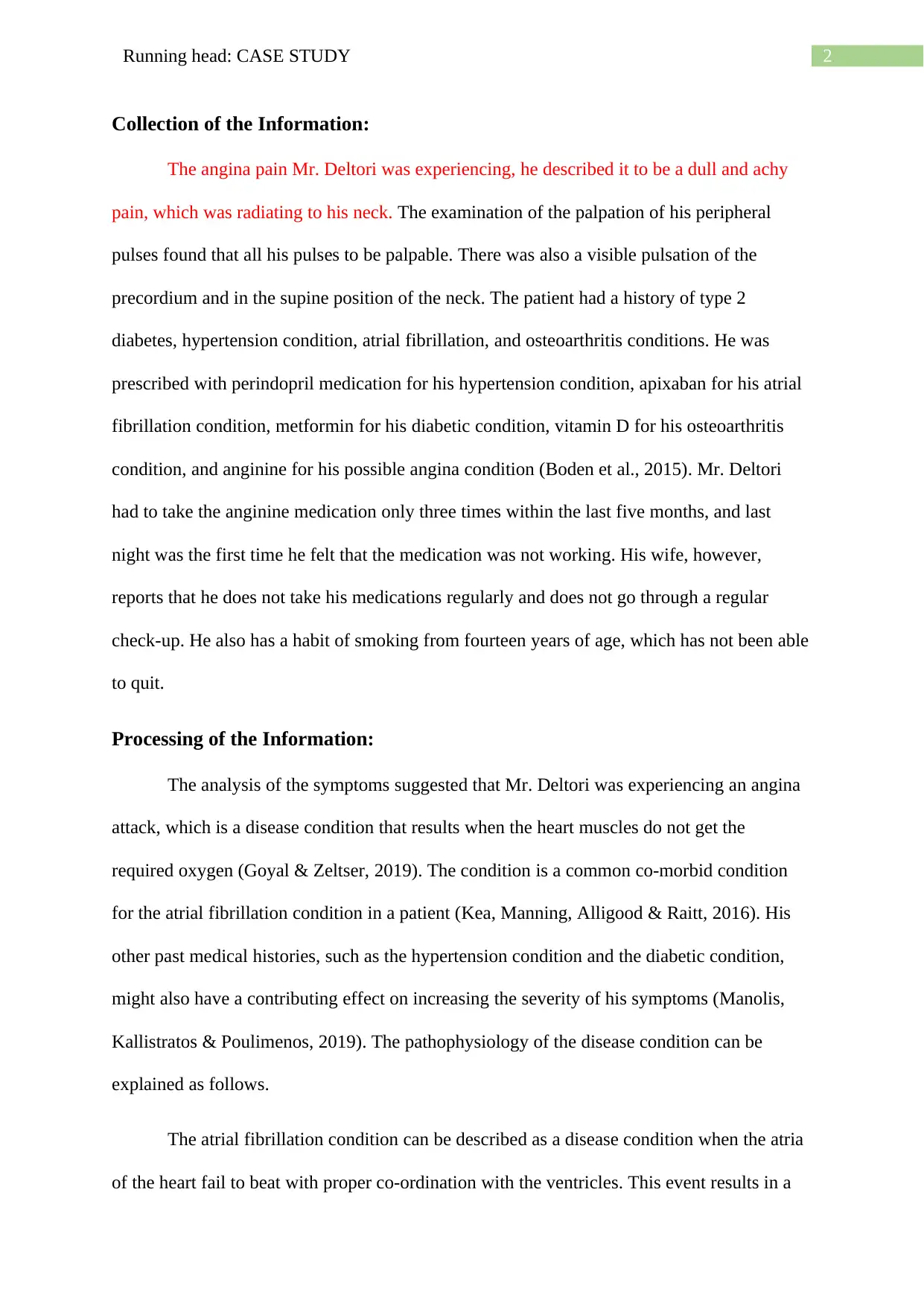
2Running head: CASE STUDY
Collection of the Information:
The angina pain Mr. Deltori was experiencing, he described it to be a dull and achy
pain, which was radiating to his neck. The examination of the palpation of his peripheral
pulses found that all his pulses to be palpable. There was also a visible pulsation of the
precordium and in the supine position of the neck. The patient had a history of type 2
diabetes, hypertension condition, atrial fibrillation, and osteoarthritis conditions. He was
prescribed with perindopril medication for his hypertension condition, apixaban for his atrial
fibrillation condition, metformin for his diabetic condition, vitamin D for his osteoarthritis
condition, and anginine for his possible angina condition (Boden et al., 2015). Mr. Deltori
had to take the anginine medication only three times within the last five months, and last
night was the first time he felt that the medication was not working. His wife, however,
reports that he does not take his medications regularly and does not go through a regular
check-up. He also has a habit of smoking from fourteen years of age, which has not been able
to quit.
Processing of the Information:
The analysis of the symptoms suggested that Mr. Deltori was experiencing an angina
attack, which is a disease condition that results when the heart muscles do not get the
required oxygen (Goyal & Zeltser, 2019). The condition is a common co-morbid condition
for the atrial fibrillation condition in a patient (Kea, Manning, Alligood & Raitt, 2016). His
other past medical histories, such as the hypertension condition and the diabetic condition,
might also have a contributing effect on increasing the severity of his symptoms (Manolis,
Kallistratos & Poulimenos, 2019). The pathophysiology of the disease condition can be
explained as follows.
The atrial fibrillation condition can be described as a disease condition when the atria
of the heart fail to beat with proper co-ordination with the ventricles. This event results in a
Collection of the Information:
The angina pain Mr. Deltori was experiencing, he described it to be a dull and achy
pain, which was radiating to his neck. The examination of the palpation of his peripheral
pulses found that all his pulses to be palpable. There was also a visible pulsation of the
precordium and in the supine position of the neck. The patient had a history of type 2
diabetes, hypertension condition, atrial fibrillation, and osteoarthritis conditions. He was
prescribed with perindopril medication for his hypertension condition, apixaban for his atrial
fibrillation condition, metformin for his diabetic condition, vitamin D for his osteoarthritis
condition, and anginine for his possible angina condition (Boden et al., 2015). Mr. Deltori
had to take the anginine medication only three times within the last five months, and last
night was the first time he felt that the medication was not working. His wife, however,
reports that he does not take his medications regularly and does not go through a regular
check-up. He also has a habit of smoking from fourteen years of age, which has not been able
to quit.
Processing of the Information:
The analysis of the symptoms suggested that Mr. Deltori was experiencing an angina
attack, which is a disease condition that results when the heart muscles do not get the
required oxygen (Goyal & Zeltser, 2019). The condition is a common co-morbid condition
for the atrial fibrillation condition in a patient (Kea, Manning, Alligood & Raitt, 2016). His
other past medical histories, such as the hypertension condition and the diabetic condition,
might also have a contributing effect on increasing the severity of his symptoms (Manolis,
Kallistratos & Poulimenos, 2019). The pathophysiology of the disease condition can be
explained as follows.
The atrial fibrillation condition can be described as a disease condition when the atria
of the heart fail to beat with proper co-ordination with the ventricles. This event results in a
⊘ This is a preview!⊘
Do you want full access?
Subscribe today to unlock all pages.

Trusted by 1+ million students worldwide
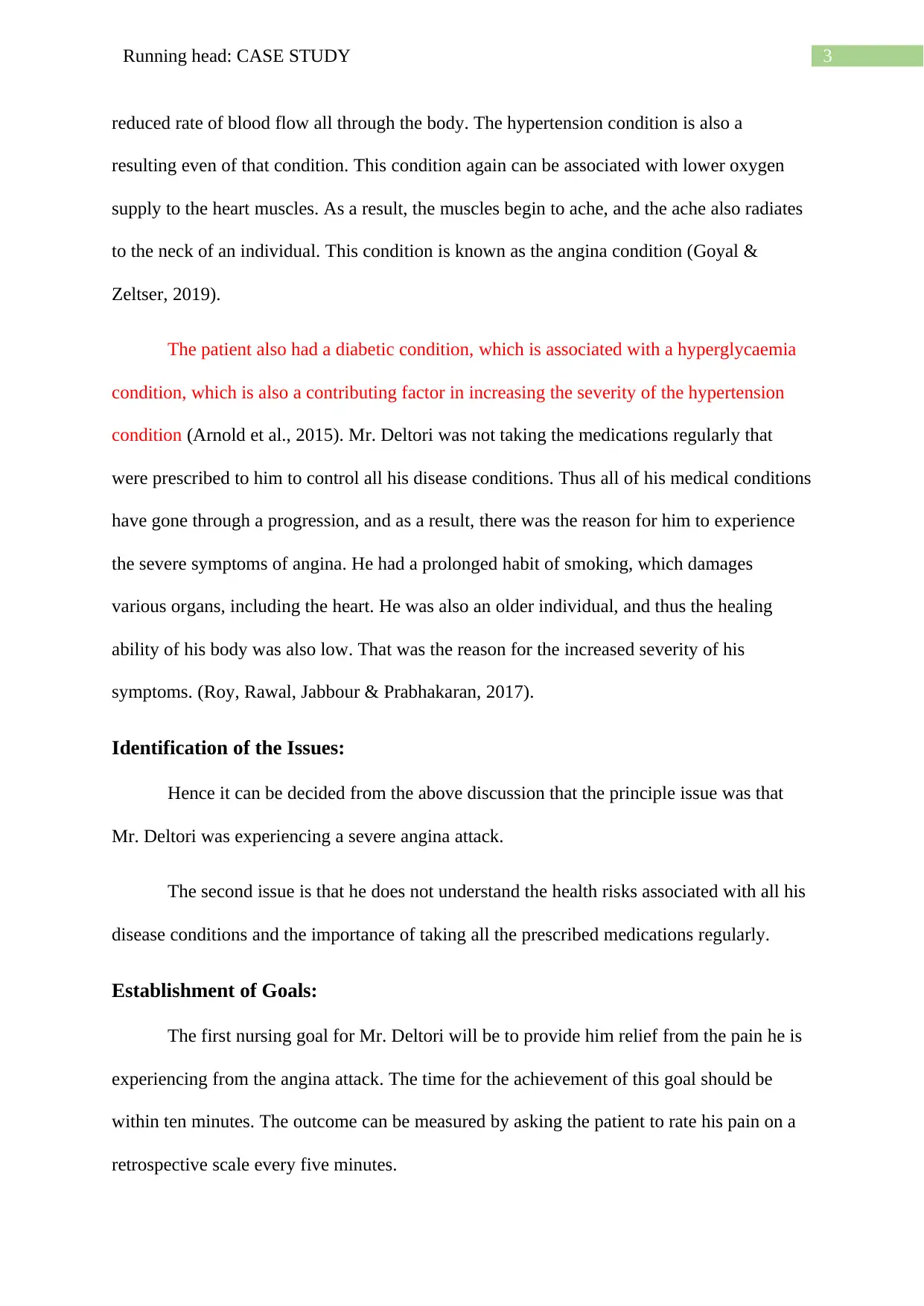
3Running head: CASE STUDY
reduced rate of blood flow all through the body. The hypertension condition is also a
resulting even of that condition. This condition again can be associated with lower oxygen
supply to the heart muscles. As a result, the muscles begin to ache, and the ache also radiates
to the neck of an individual. This condition is known as the angina condition (Goyal &
Zeltser, 2019).
The patient also had a diabetic condition, which is associated with a hyperglycaemia
condition, which is also a contributing factor in increasing the severity of the hypertension
condition (Arnold et al., 2015). Mr. Deltori was not taking the medications regularly that
were prescribed to him to control all his disease conditions. Thus all of his medical conditions
have gone through a progression, and as a result, there was the reason for him to experience
the severe symptoms of angina. He had a prolonged habit of smoking, which damages
various organs, including the heart. He was also an older individual, and thus the healing
ability of his body was also low. That was the reason for the increased severity of his
symptoms. (Roy, Rawal, Jabbour & Prabhakaran, 2017).
Identification of the Issues:
Hence it can be decided from the above discussion that the principle issue was that
Mr. Deltori was experiencing a severe angina attack.
The second issue is that he does not understand the health risks associated with all his
disease conditions and the importance of taking all the prescribed medications regularly.
Establishment of Goals:
The first nursing goal for Mr. Deltori will be to provide him relief from the pain he is
experiencing from the angina attack. The time for the achievement of this goal should be
within ten minutes. The outcome can be measured by asking the patient to rate his pain on a
retrospective scale every five minutes.
reduced rate of blood flow all through the body. The hypertension condition is also a
resulting even of that condition. This condition again can be associated with lower oxygen
supply to the heart muscles. As a result, the muscles begin to ache, and the ache also radiates
to the neck of an individual. This condition is known as the angina condition (Goyal &
Zeltser, 2019).
The patient also had a diabetic condition, which is associated with a hyperglycaemia
condition, which is also a contributing factor in increasing the severity of the hypertension
condition (Arnold et al., 2015). Mr. Deltori was not taking the medications regularly that
were prescribed to him to control all his disease conditions. Thus all of his medical conditions
have gone through a progression, and as a result, there was the reason for him to experience
the severe symptoms of angina. He had a prolonged habit of smoking, which damages
various organs, including the heart. He was also an older individual, and thus the healing
ability of his body was also low. That was the reason for the increased severity of his
symptoms. (Roy, Rawal, Jabbour & Prabhakaran, 2017).
Identification of the Issues:
Hence it can be decided from the above discussion that the principle issue was that
Mr. Deltori was experiencing a severe angina attack.
The second issue is that he does not understand the health risks associated with all his
disease conditions and the importance of taking all the prescribed medications regularly.
Establishment of Goals:
The first nursing goal for Mr. Deltori will be to provide him relief from the pain he is
experiencing from the angina attack. The time for the achievement of this goal should be
within ten minutes. The outcome can be measured by asking the patient to rate his pain on a
retrospective scale every five minutes.
Paraphrase This Document
Need a fresh take? Get an instant paraphrase of this document with our AI Paraphraser
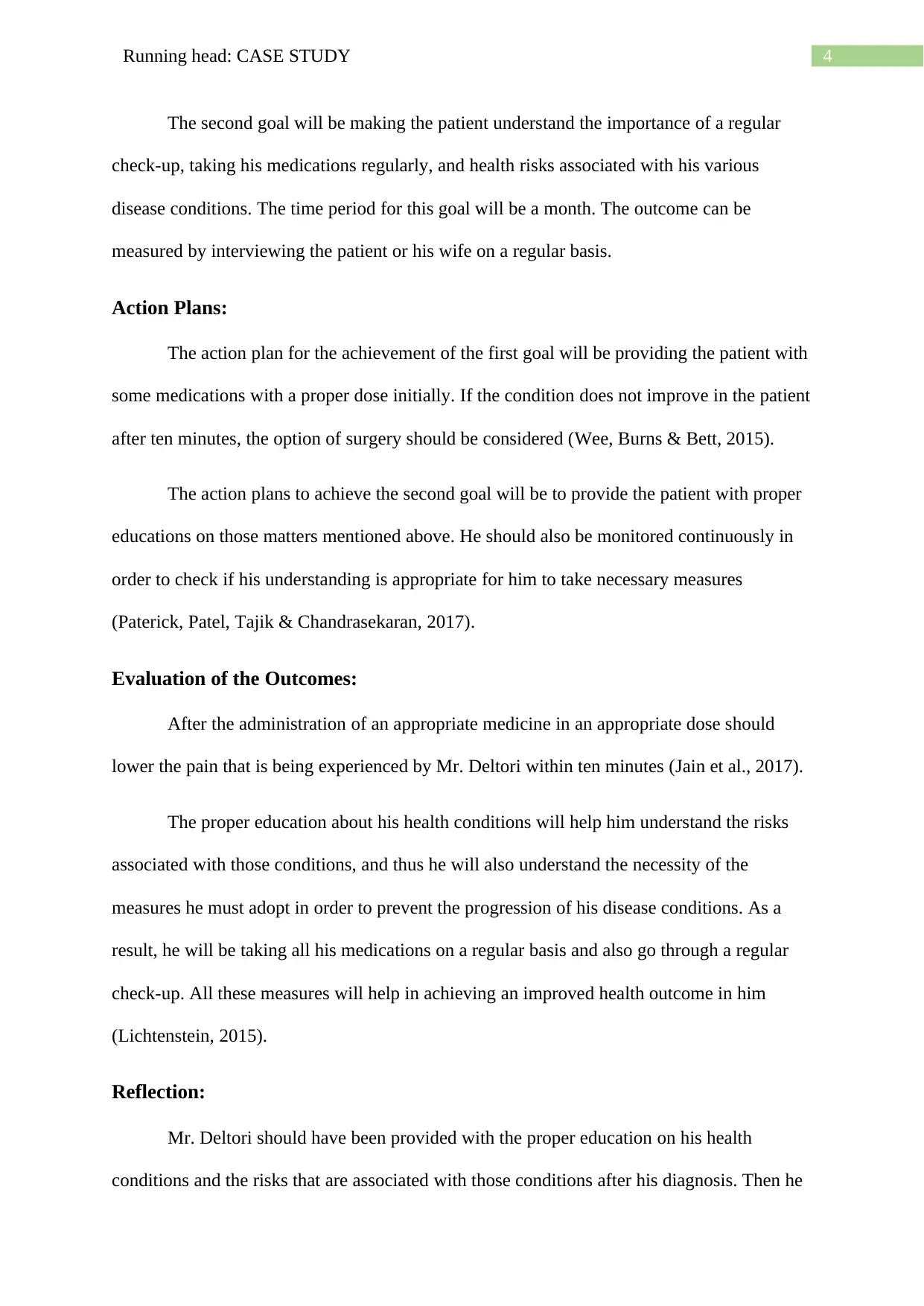
4Running head: CASE STUDY
The second goal will be making the patient understand the importance of a regular
check-up, taking his medications regularly, and health risks associated with his various
disease conditions. The time period for this goal will be a month. The outcome can be
measured by interviewing the patient or his wife on a regular basis.
Action Plans:
The action plan for the achievement of the first goal will be providing the patient with
some medications with a proper dose initially. If the condition does not improve in the patient
after ten minutes, the option of surgery should be considered (Wee, Burns & Bett, 2015).
The action plans to achieve the second goal will be to provide the patient with proper
educations on those matters mentioned above. He should also be monitored continuously in
order to check if his understanding is appropriate for him to take necessary measures
(Paterick, Patel, Tajik & Chandrasekaran, 2017).
Evaluation of the Outcomes:
After the administration of an appropriate medicine in an appropriate dose should
lower the pain that is being experienced by Mr. Deltori within ten minutes (Jain et al., 2017).
The proper education about his health conditions will help him understand the risks
associated with those conditions, and thus he will also understand the necessity of the
measures he must adopt in order to prevent the progression of his disease conditions. As a
result, he will be taking all his medications on a regular basis and also go through a regular
check-up. All these measures will help in achieving an improved health outcome in him
(Lichtenstein, 2015).
Reflection:
Mr. Deltori should have been provided with the proper education on his health
conditions and the risks that are associated with those conditions after his diagnosis. Then he
The second goal will be making the patient understand the importance of a regular
check-up, taking his medications regularly, and health risks associated with his various
disease conditions. The time period for this goal will be a month. The outcome can be
measured by interviewing the patient or his wife on a regular basis.
Action Plans:
The action plan for the achievement of the first goal will be providing the patient with
some medications with a proper dose initially. If the condition does not improve in the patient
after ten minutes, the option of surgery should be considered (Wee, Burns & Bett, 2015).
The action plans to achieve the second goal will be to provide the patient with proper
educations on those matters mentioned above. He should also be monitored continuously in
order to check if his understanding is appropriate for him to take necessary measures
(Paterick, Patel, Tajik & Chandrasekaran, 2017).
Evaluation of the Outcomes:
After the administration of an appropriate medicine in an appropriate dose should
lower the pain that is being experienced by Mr. Deltori within ten minutes (Jain et al., 2017).
The proper education about his health conditions will help him understand the risks
associated with those conditions, and thus he will also understand the necessity of the
measures he must adopt in order to prevent the progression of his disease conditions. As a
result, he will be taking all his medications on a regular basis and also go through a regular
check-up. All these measures will help in achieving an improved health outcome in him
(Lichtenstein, 2015).
Reflection:
Mr. Deltori should have been provided with the proper education on his health
conditions and the risks that are associated with those conditions after his diagnosis. Then he
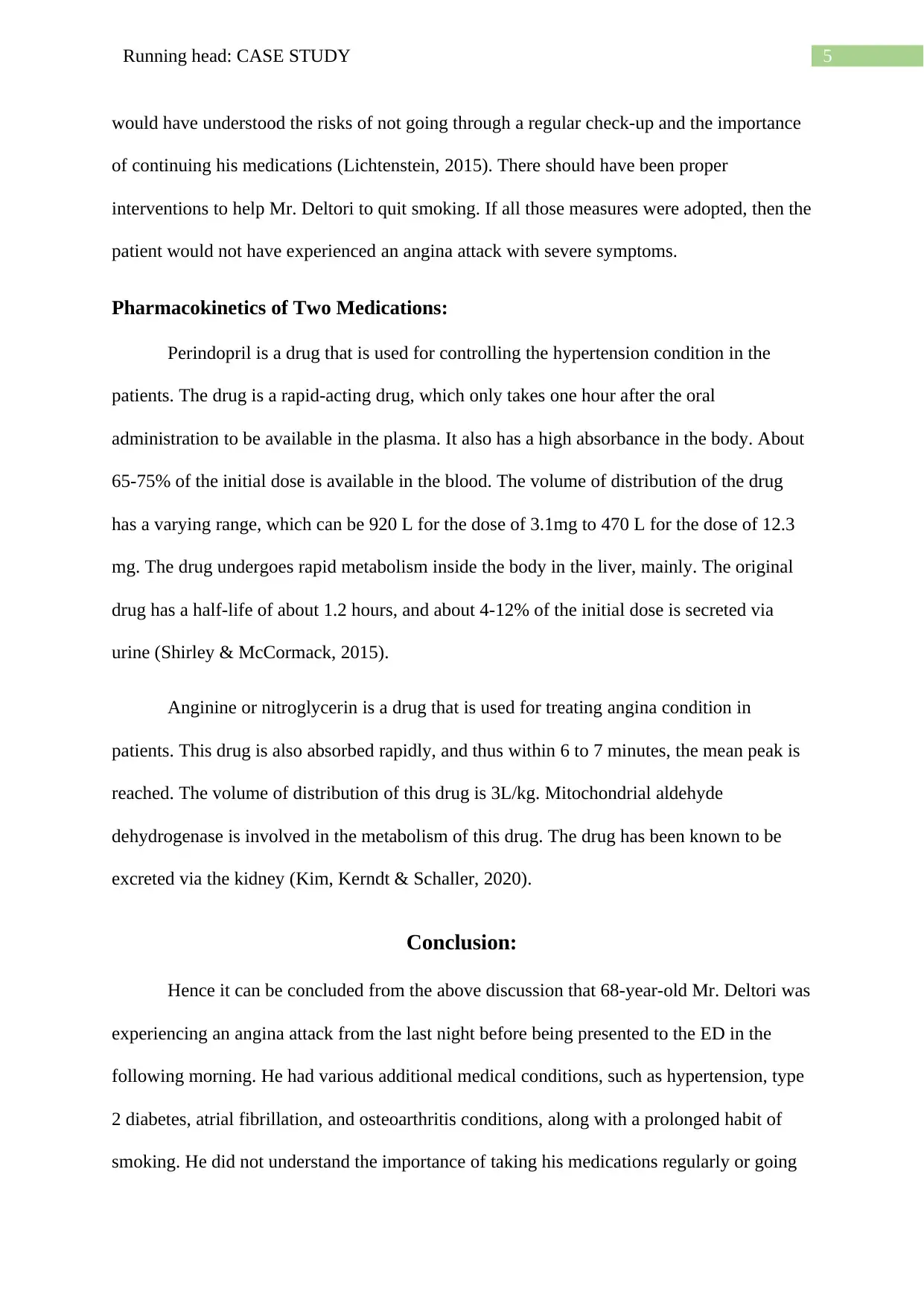
5Running head: CASE STUDY
would have understood the risks of not going through a regular check-up and the importance
of continuing his medications (Lichtenstein, 2015). There should have been proper
interventions to help Mr. Deltori to quit smoking. If all those measures were adopted, then the
patient would not have experienced an angina attack with severe symptoms.
Pharmacokinetics of Two Medications:
Perindopril is a drug that is used for controlling the hypertension condition in the
patients. The drug is a rapid-acting drug, which only takes one hour after the oral
administration to be available in the plasma. It also has a high absorbance in the body. About
65-75% of the initial dose is available in the blood. The volume of distribution of the drug
has a varying range, which can be 920 L for the dose of 3.1mg to 470 L for the dose of 12.3
mg. The drug undergoes rapid metabolism inside the body in the liver, mainly. The original
drug has a half-life of about 1.2 hours, and about 4-12% of the initial dose is secreted via
urine (Shirley & McCormack, 2015).
Anginine or nitroglycerin is a drug that is used for treating angina condition in
patients. This drug is also absorbed rapidly, and thus within 6 to 7 minutes, the mean peak is
reached. The volume of distribution of this drug is 3L/kg. Mitochondrial aldehyde
dehydrogenase is involved in the metabolism of this drug. The drug has been known to be
excreted via the kidney (Kim, Kerndt & Schaller, 2020).
Conclusion:
Hence it can be concluded from the above discussion that 68-year-old Mr. Deltori was
experiencing an angina attack from the last night before being presented to the ED in the
following morning. He had various additional medical conditions, such as hypertension, type
2 diabetes, atrial fibrillation, and osteoarthritis conditions, along with a prolonged habit of
smoking. He did not understand the importance of taking his medications regularly or going
would have understood the risks of not going through a regular check-up and the importance
of continuing his medications (Lichtenstein, 2015). There should have been proper
interventions to help Mr. Deltori to quit smoking. If all those measures were adopted, then the
patient would not have experienced an angina attack with severe symptoms.
Pharmacokinetics of Two Medications:
Perindopril is a drug that is used for controlling the hypertension condition in the
patients. The drug is a rapid-acting drug, which only takes one hour after the oral
administration to be available in the plasma. It also has a high absorbance in the body. About
65-75% of the initial dose is available in the blood. The volume of distribution of the drug
has a varying range, which can be 920 L for the dose of 3.1mg to 470 L for the dose of 12.3
mg. The drug undergoes rapid metabolism inside the body in the liver, mainly. The original
drug has a half-life of about 1.2 hours, and about 4-12% of the initial dose is secreted via
urine (Shirley & McCormack, 2015).
Anginine or nitroglycerin is a drug that is used for treating angina condition in
patients. This drug is also absorbed rapidly, and thus within 6 to 7 minutes, the mean peak is
reached. The volume of distribution of this drug is 3L/kg. Mitochondrial aldehyde
dehydrogenase is involved in the metabolism of this drug. The drug has been known to be
excreted via the kidney (Kim, Kerndt & Schaller, 2020).
Conclusion:
Hence it can be concluded from the above discussion that 68-year-old Mr. Deltori was
experiencing an angina attack from the last night before being presented to the ED in the
following morning. He had various additional medical conditions, such as hypertension, type
2 diabetes, atrial fibrillation, and osteoarthritis conditions, along with a prolonged habit of
smoking. He did not understand the importance of taking his medications regularly or going
⊘ This is a preview!⊘
Do you want full access?
Subscribe today to unlock all pages.

Trusted by 1+ million students worldwide
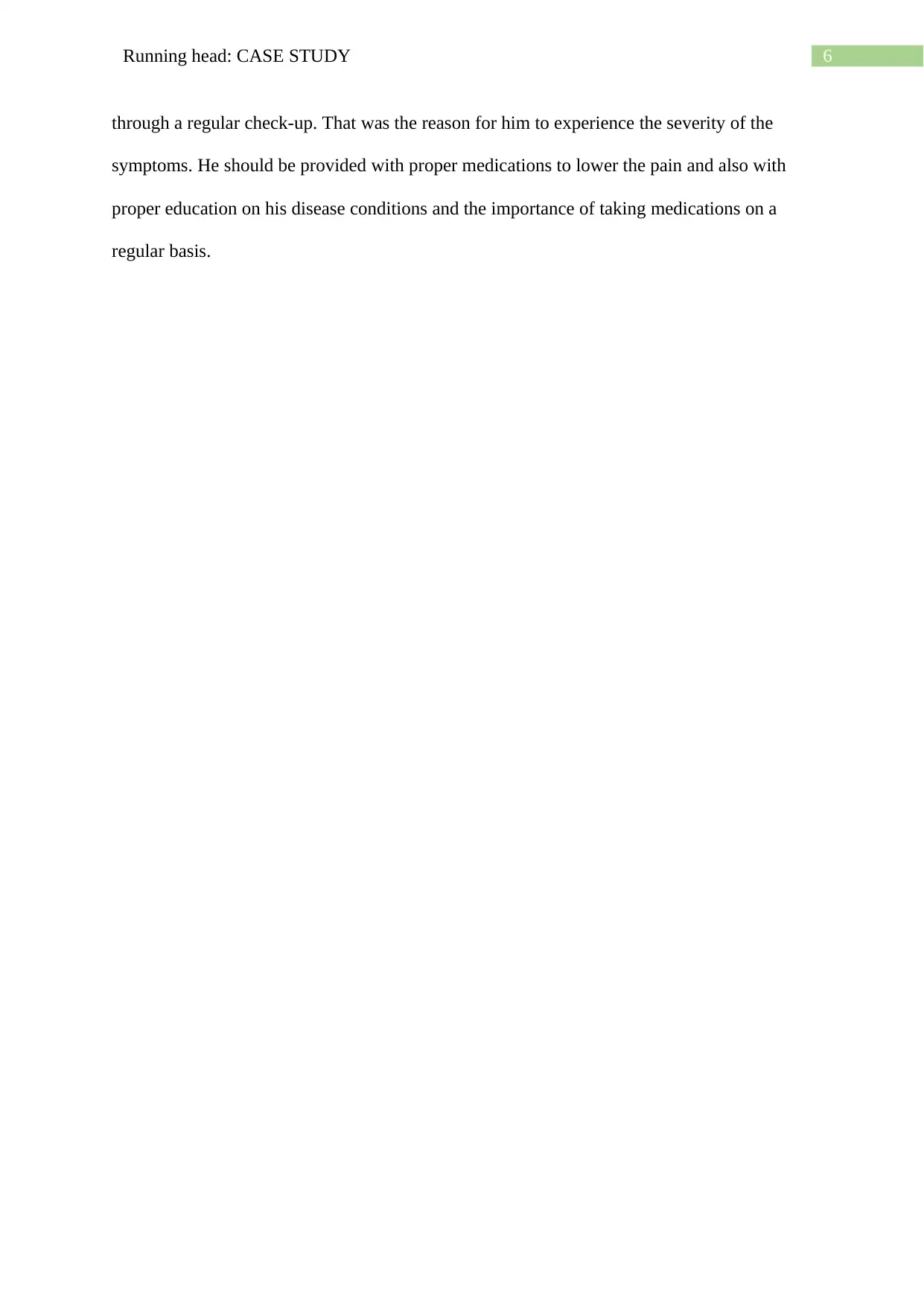
6Running head: CASE STUDY
through a regular check-up. That was the reason for him to experience the severity of the
symptoms. He should be provided with proper medications to lower the pain and also with
proper education on his disease conditions and the importance of taking medications on a
regular basis.
through a regular check-up. That was the reason for him to experience the severity of the
symptoms. He should be provided with proper medications to lower the pain and also with
proper education on his disease conditions and the importance of taking medications on a
regular basis.
Paraphrase This Document
Need a fresh take? Get an instant paraphrase of this document with our AI Paraphraser
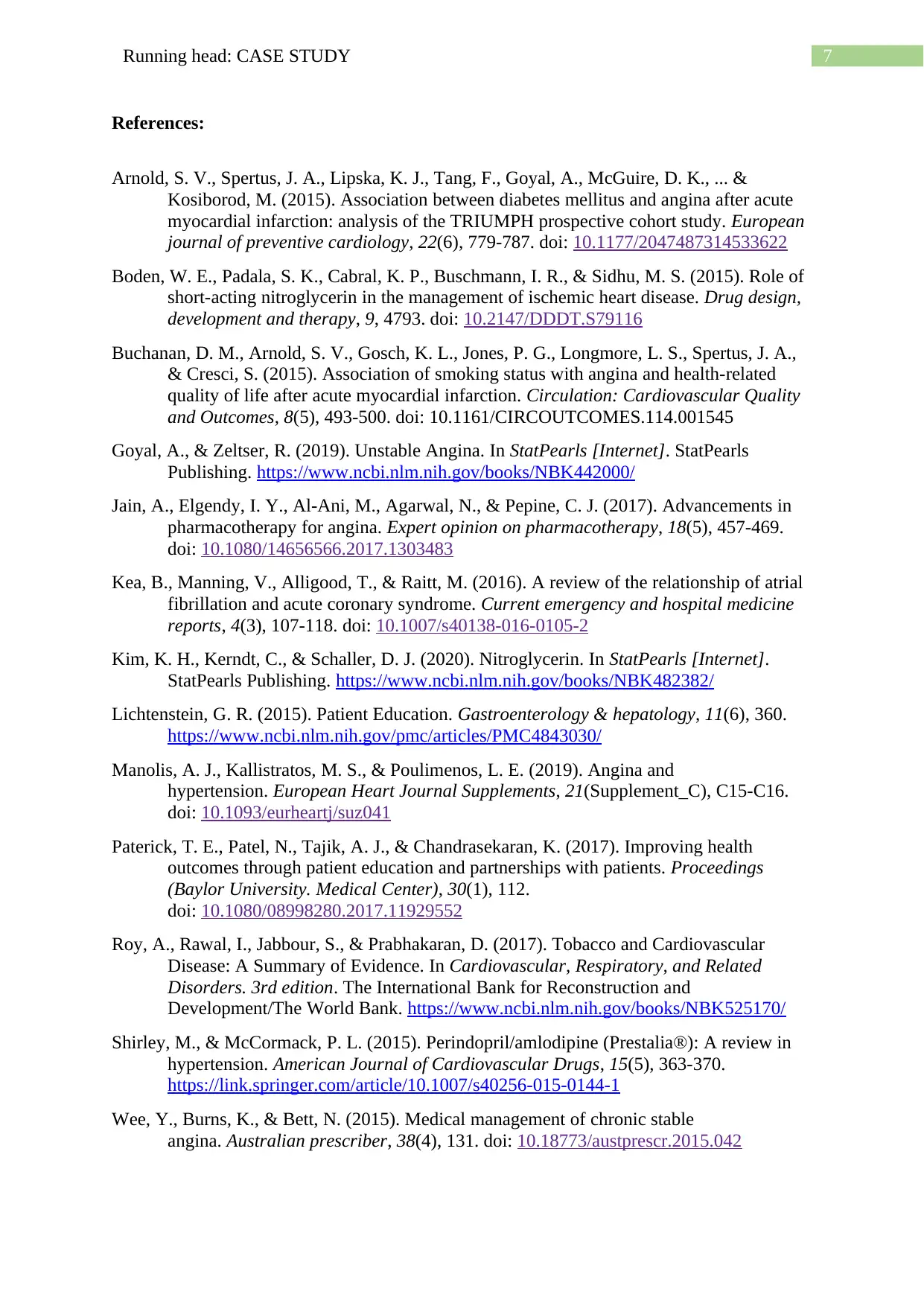
7Running head: CASE STUDY
References:
Arnold, S. V., Spertus, J. A., Lipska, K. J., Tang, F., Goyal, A., McGuire, D. K., ... &
Kosiborod, M. (2015). Association between diabetes mellitus and angina after acute
myocardial infarction: analysis of the TRIUMPH prospective cohort study. European
journal of preventive cardiology, 22(6), 779-787. doi: 10.1177/2047487314533622
Boden, W. E., Padala, S. K., Cabral, K. P., Buschmann, I. R., & Sidhu, M. S. (2015). Role of
short-acting nitroglycerin in the management of ischemic heart disease. Drug design,
development and therapy, 9, 4793. doi: 10.2147/DDDT.S79116
Buchanan, D. M., Arnold, S. V., Gosch, K. L., Jones, P. G., Longmore, L. S., Spertus, J. A.,
& Cresci, S. (2015). Association of smoking status with angina and health-related
quality of life after acute myocardial infarction. Circulation: Cardiovascular Quality
and Outcomes, 8(5), 493-500. doi: 10.1161/CIRCOUTCOMES.114.001545
Goyal, A., & Zeltser, R. (2019). Unstable Angina. In StatPearls [Internet]. StatPearls
Publishing. https://www.ncbi.nlm.nih.gov/books/NBK442000/
Jain, A., Elgendy, I. Y., Al-Ani, M., Agarwal, N., & Pepine, C. J. (2017). Advancements in
pharmacotherapy for angina. Expert opinion on pharmacotherapy, 18(5), 457-469.
doi: 10.1080/14656566.2017.1303483
Kea, B., Manning, V., Alligood, T., & Raitt, M. (2016). A review of the relationship of atrial
fibrillation and acute coronary syndrome. Current emergency and hospital medicine
reports, 4(3), 107-118. doi: 10.1007/s40138-016-0105-2
Kim, K. H., Kerndt, C., & Schaller, D. J. (2020). Nitroglycerin. In StatPearls [Internet].
StatPearls Publishing. https://www.ncbi.nlm.nih.gov/books/NBK482382/
Lichtenstein, G. R. (2015). Patient Education. Gastroenterology & hepatology, 11(6), 360.
https://www.ncbi.nlm.nih.gov/pmc/articles/PMC4843030/
Manolis, A. J., Kallistratos, M. S., & Poulimenos, L. E. (2019). Angina and
hypertension. European Heart Journal Supplements, 21(Supplement_C), C15-C16.
doi: 10.1093/eurheartj/suz041
Paterick, T. E., Patel, N., Tajik, A. J., & Chandrasekaran, K. (2017). Improving health
outcomes through patient education and partnerships with patients. Proceedings
(Baylor University. Medical Center), 30(1), 112.
doi: 10.1080/08998280.2017.11929552
Roy, A., Rawal, I., Jabbour, S., & Prabhakaran, D. (2017). Tobacco and Cardiovascular
Disease: A Summary of Evidence. In Cardiovascular, Respiratory, and Related
Disorders. 3rd edition. The International Bank for Reconstruction and
Development/The World Bank. https://www.ncbi.nlm.nih.gov/books/NBK525170/
Shirley, M., & McCormack, P. L. (2015). Perindopril/amlodipine (Prestalia®): A review in
hypertension. American Journal of Cardiovascular Drugs, 15(5), 363-370.
https://link.springer.com/article/10.1007/s40256-015-0144-1
Wee, Y., Burns, K., & Bett, N. (2015). Medical management of chronic stable
angina. Australian prescriber, 38(4), 131. doi: 10.18773/austprescr.2015.042
References:
Arnold, S. V., Spertus, J. A., Lipska, K. J., Tang, F., Goyal, A., McGuire, D. K., ... &
Kosiborod, M. (2015). Association between diabetes mellitus and angina after acute
myocardial infarction: analysis of the TRIUMPH prospective cohort study. European
journal of preventive cardiology, 22(6), 779-787. doi: 10.1177/2047487314533622
Boden, W. E., Padala, S. K., Cabral, K. P., Buschmann, I. R., & Sidhu, M. S. (2015). Role of
short-acting nitroglycerin in the management of ischemic heart disease. Drug design,
development and therapy, 9, 4793. doi: 10.2147/DDDT.S79116
Buchanan, D. M., Arnold, S. V., Gosch, K. L., Jones, P. G., Longmore, L. S., Spertus, J. A.,
& Cresci, S. (2015). Association of smoking status with angina and health-related
quality of life after acute myocardial infarction. Circulation: Cardiovascular Quality
and Outcomes, 8(5), 493-500. doi: 10.1161/CIRCOUTCOMES.114.001545
Goyal, A., & Zeltser, R. (2019). Unstable Angina. In StatPearls [Internet]. StatPearls
Publishing. https://www.ncbi.nlm.nih.gov/books/NBK442000/
Jain, A., Elgendy, I. Y., Al-Ani, M., Agarwal, N., & Pepine, C. J. (2017). Advancements in
pharmacotherapy for angina. Expert opinion on pharmacotherapy, 18(5), 457-469.
doi: 10.1080/14656566.2017.1303483
Kea, B., Manning, V., Alligood, T., & Raitt, M. (2016). A review of the relationship of atrial
fibrillation and acute coronary syndrome. Current emergency and hospital medicine
reports, 4(3), 107-118. doi: 10.1007/s40138-016-0105-2
Kim, K. H., Kerndt, C., & Schaller, D. J. (2020). Nitroglycerin. In StatPearls [Internet].
StatPearls Publishing. https://www.ncbi.nlm.nih.gov/books/NBK482382/
Lichtenstein, G. R. (2015). Patient Education. Gastroenterology & hepatology, 11(6), 360.
https://www.ncbi.nlm.nih.gov/pmc/articles/PMC4843030/
Manolis, A. J., Kallistratos, M. S., & Poulimenos, L. E. (2019). Angina and
hypertension. European Heart Journal Supplements, 21(Supplement_C), C15-C16.
doi: 10.1093/eurheartj/suz041
Paterick, T. E., Patel, N., Tajik, A. J., & Chandrasekaran, K. (2017). Improving health
outcomes through patient education and partnerships with patients. Proceedings
(Baylor University. Medical Center), 30(1), 112.
doi: 10.1080/08998280.2017.11929552
Roy, A., Rawal, I., Jabbour, S., & Prabhakaran, D. (2017). Tobacco and Cardiovascular
Disease: A Summary of Evidence. In Cardiovascular, Respiratory, and Related
Disorders. 3rd edition. The International Bank for Reconstruction and
Development/The World Bank. https://www.ncbi.nlm.nih.gov/books/NBK525170/
Shirley, M., & McCormack, P. L. (2015). Perindopril/amlodipine (Prestalia®): A review in
hypertension. American Journal of Cardiovascular Drugs, 15(5), 363-370.
https://link.springer.com/article/10.1007/s40256-015-0144-1
Wee, Y., Burns, K., & Bett, N. (2015). Medical management of chronic stable
angina. Australian prescriber, 38(4), 131. doi: 10.18773/austprescr.2015.042
1 out of 8
Related Documents
Your All-in-One AI-Powered Toolkit for Academic Success.
+13062052269
info@desklib.com
Available 24*7 on WhatsApp / Email
![[object Object]](/_next/static/media/star-bottom.7253800d.svg)
Unlock your academic potential
Copyright © 2020–2025 A2Z Services. All Rights Reserved. Developed and managed by ZUCOL.





